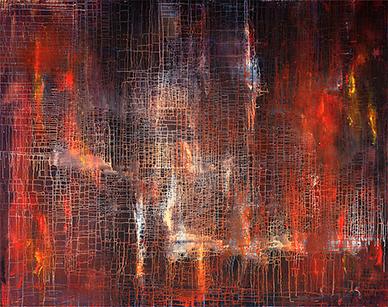Barbara Morris, art ltd.
Bay area-based artist Yari Ostovany has traveled far from his birthplace of Iran, which he left shortly after the beginning of the revolution, to his current home in Oakland. His journey has taken him through the MFA program at the San Francisco Art Institute, as well as a lengthy residence in Cologne, Germany. Ostovany’s medium to large-scale works are process-based and meditative, reflecting his interests in poetry and music, as well as a blending of Eastern and Western cultures.

Chellehneshin 14 (2012) refers to a period of 40 days of praying and meditation, combining Persian words “chelleh,” period of 40 days, and “neshin,” sitting. Amorphous forms in warm hues—alizarin, orange, ochers and umbers—dissolve into skeins of drips, sketching out a loose grid; turning the work side to side, using gravity as a painting tool is very much an important part of his working process. In Fragments of Poetry and Silence No. 26 (2014) darker underpainting is overlaid with washy veils of oil paint in hues of peach, yellow and red. Rebuilding Goya I (2002), a large, dark and moody work—in an homage to the Spanish master—displays a scruffy dull area of browns, grays, and gray-greens on right, with ocher linear elements suggesting trees, dissolving into a glowing field of peachy hues on the left. Contrasts between thick and thin, dull and shiny, muted and vibrant color retain our interest, along with multi-directional thrusts of painted and dripped passages.
Conference of the Birds No. 50 (2011) presents beautiful atmospheric effects in pinks and pale blues in a small acrylic work, somewhat evocative of the light effects of Turner. This series was inspired by the 12th-century Sufi allegorical tale of a flock of birds searching for a ruler, the Phoenix, which resolves with a didactic double entendre in Persian. As in much of Ostovany’s work, one has the sense that deep study and meditation on the literature, art and traditions of numerous cultures spark impulses that generate painterly gestures and choices, yet no specific narrative or figurative content arises. Grosse Fuge (for Ludwig van Beethoven) (2013), grounded in browns and alizarin, is layered with lattices of red, pink and cream. Flame-like tongues of yellow shoot up on left. The title refers to one of Ostovany’s multitude of interests, singing with the SF Choral Society. Ostovany brings a cosmopolitan perspective and profoundly thoughtful sensibility to these luminous, well-crafted works. Their subtle aura lingers after viewing, like a harmonic vibration.
San Francisco, November 2014.